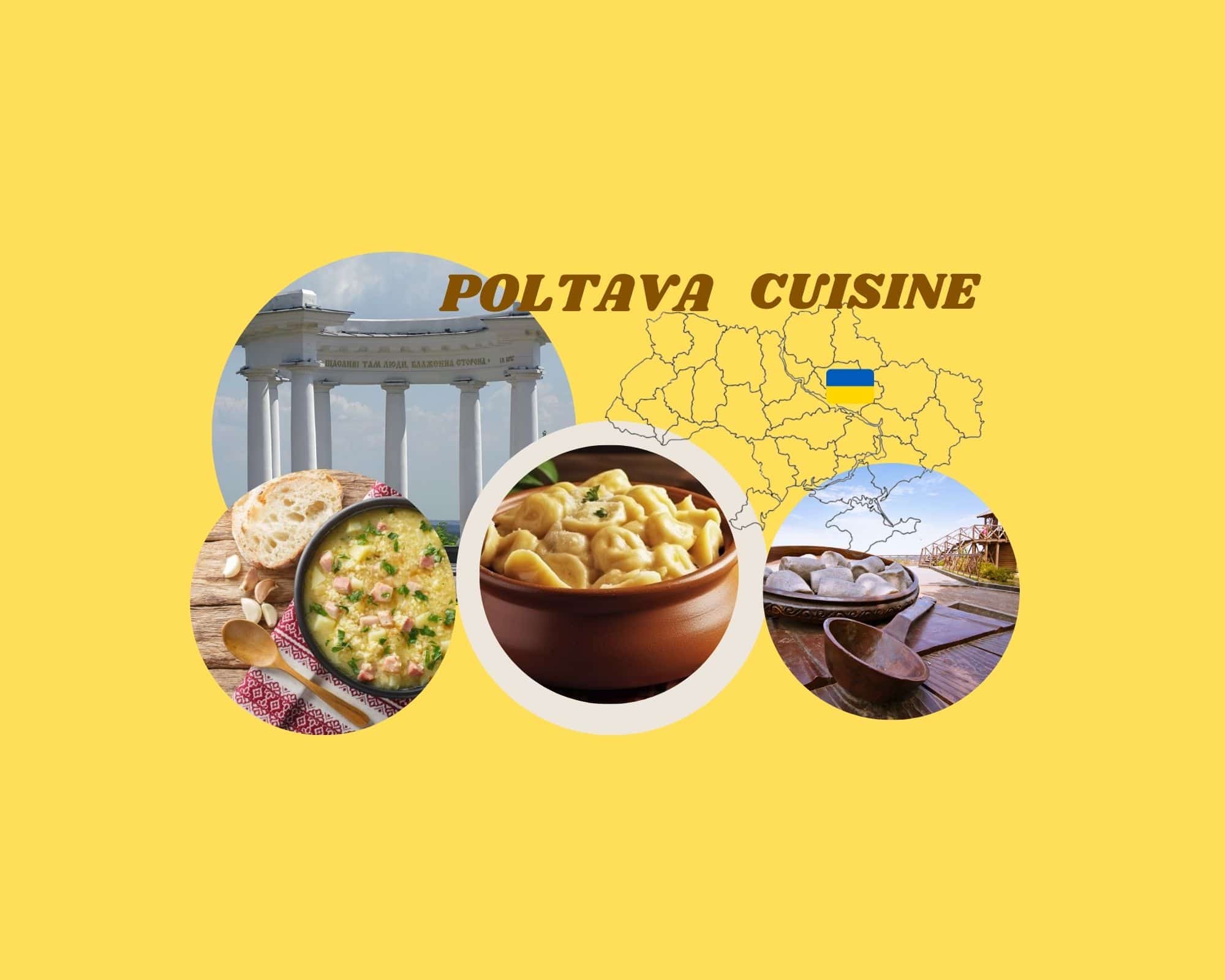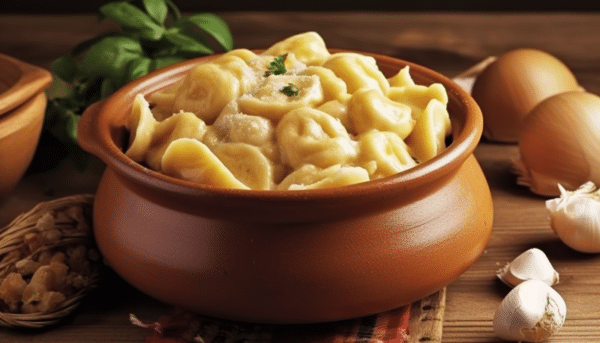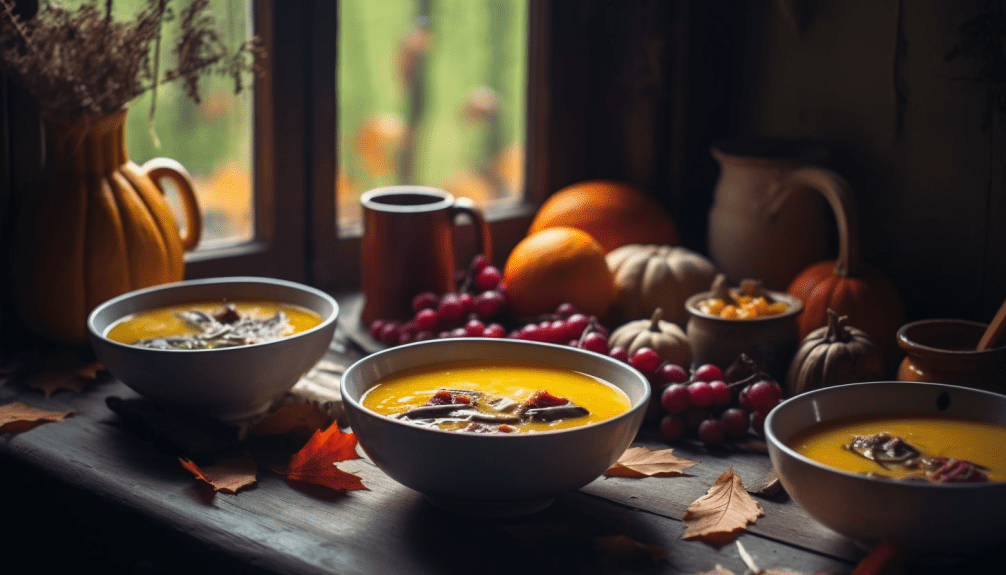Poltava is a city rich in history and culture, located in central Ukraine. It stands out not only for its historical monuments and scenic beauty but also for its unique and delicious cuisine, which has become a staple of Ukrainian culinary traditions. Poltava’s food culture reflects the agricultural richness of the region and is steeped in the history of Ukrainian rural life. The area is famous for its hearty and diverse dishes, each of which holds a special place in Ukraine’s national identity.
In this article, we will explore the traditional dishes of Poltava, their significance in Ukrainian culture, and how they are made. From famous Poltava dumplings (galushky) to lesser-known but equally important dishes like kulish and shpundra, this culinary journey through Poltava will highlight the richness of Ukrainian food culture. Along the way, we will discuss Poltava’s agricultural background, how seasonal ingredients shape local dishes, and how Poltava’s cuisine mirrors Ukraine’s cultural heritage.
Let’s dive deeper into some of the most popular dishes of Poltava, starting with one that has earned international recognition.
First dishes in Poltava cuisine
Poltava cuisine, rich in history and tradition, places great importance on first dishes. These meals, typically soups or broths, have been a staple in Ukrainian households for centuries. They were not only a source of nourishment but also a reflection of the agricultural lifestyle of the region, relying heavily on locally sourced ingredients like vegetables, grains, and meats.
Yushka: The ancient soup
In ancient times, the general term for first dishes was yushka, a clear broth or soup that could be made with fish, meat, or vegetables. The renowned Ukrainian writer Ivan Petrovich Kotliarevskyi mentions 147 different dishes in his famous work, the “Eneida,” among which yushka plays a prominent role. He writes, “Seven cauldrons stood with yushka, and in four there were galushky,” highlighting the importance of this dish in the region.
While yushka was commonly served hot, the people of Poltava also prepared a summer version of the dish known as kholodnyk, or cold borscht. This refreshing meal consisted of boiled beets served in whey or sour milk, providing a cooling and nutritious option during the hot summer months.
Borscht: The quintessential Ukrainian dish
When talking about Ukrainian cuisine, one dish stands out above all others – borscht. A favorite throughout the country, borscht is deeply rooted in the culture and traditions of Poltava. The saying, “Where there is borscht and cabbage in the house, there the house is not empty,” speaks to its significance in daily life.
In Poltava, all three main varieties of traditional Ukrainian borscht were prepared:
- Red borscht, made with beets, cabbage, potatoes, and sometimes meat, is perhaps the most well-known.
- Sorrel borscht, which uses the tangy flavor of sorrel leaves in place of beets, offering a lighter, more acidic taste.
- Cold borscht, a summer dish made with boiled beets, served chilled with whey or sour milk.
However, Poltava is particularly known for its unique variation: Poltava borscht with galushky. This special version of borscht includes galushky – soft, pillowy dough dumplings – which add heartiness to the dish. Borscht was traditionally served as the first course for lunch and was also a central part of festive meals, including weddings and funerals. Today, borscht remains a symbolic dish in Ukraine, and the recipe has been passed down from generation to generation, preserving its original form.
Kulish: The cossack’s favorite soup
Another beloved first dish in Poltava and across Ukraine is kulish, a thick and hearty soup made from millet or buckwheat. This simple yet filling dish was particularly popular among the Cossacks and common folk due to its easy preparation and the availability of the ingredients. Kulish could be cooked over an open fire, making it a practical meal for soldiers and travelers.
There was also a forgotten dish similar to kulish known as riabko. The exact origins of this dish are unclear, but it is speculated that it may have been named after gray-red domestic dogs. Like kulish, riabko was a thick porridge-like soup that sustained many households.
Galushky: The symbol of Poltava’s culinary heritage
When people think of Poltava, one of the first things that come to mind is galushky, or dumplings. This dish has become synonymous with Poltava’s cuisine and has even been immortalized in the form of a monument to Poltava dumplings. The dumplings are made from simple ingredients – flour, water, and salе – and are either boiled or steamed until they are soft and fluffy. They are then served with butter, sour cream, or sometimes in broth.
Galushky are not just food; they are a symbol of Poltava’s cultural identity. The dish is so important to the region that Ivan Kotliarevskyi mentioned it in his famous work, “Eneida”. In his description, he notes how the characters feasted on “dumplings cooked in four pots,” illustrating the dish’s role as a hearty meal capable of feeding many.
The monument to Poltava dumplings, located in the center of Poltava, is a testament to how deeply this dish is woven into the fabric of the city’s identity. Visitors come from all over the world to see this monument and try the dumplings in local restaurants. This dish, although simple, is incredibly versatile – it can be served as a main course, side dish, or even as part of a soup like special Poltava’s borshch.
Vegetable dishes and condiments in Poltava food culture
Vegetables play an essential role in Poltava’s culinary traditions, and many of the most iconic dishes are based on seasonal products. Vegetables like beets, cucumbers, and cabbage are staples of the local diet, and they are prepared in a variety of ways depending on the season.
Among vegetable dishes, red beets were most often consumed – as an independent dish, in combination with other vegetables, and for preparing beverages. Beets served as the main ingredient for borscht. Cucumbers also held an important place in the cuisine: they were consumed fresh, pickled, salted, or marinated, and were used in cold borscht and salads. Nizhyn cucumbers were considered the tastiest.
Cabbage was consumed both raw and processed (fermented). It was used in borscht, salads, for making cabbage soup, and as a filling for pies and dumplings. Radishes were also popular, eaten as salads, combined with other vegetables, or baked.
In the 18th century, potatoes gained significant popularity among vegetables, gradually replacing many ancient flour-based dishes and earning the title of “second bread.” Potatoes were boiled in their skins or roasted over an open fire, often served with sauerkraut, pickles, milk, and seasoned with oil or fried pork fat. Various dishes were made from potatoes, such as fried potato pancakes, deruny (grated potato pancakes), and pies. Common condiments for many dishes included horseradish, garlic, and onions.
Beans were a key ingredient in soups like borsch and broths. Pumpkins, either baked or boiled, were consumed almost year-round due to their long storage life. Pumpkin porridge was particularly praised for its delicious flavor. Occasionally, fresh, fried, or salted mushrooms were added to vegetable dishes.
Bakery and dough products in Poltava cuisine
Pampushky: Poltava’s favorite buns
One of the most beloved dough products in Poltava was the pampushky – small, fluffy buns that could be served in a variety of ways. Whether baked or fried, pampushky were often flavored with garlic and served alongside hearty soups like borscht. These buns were a staple in many homes, providing a soft and savory accompaniment to various meals. In addition to the classic wheat-based pampushky, buckwheat pampuhy were also popular, offering a slightly nuttier flavor that complemented traditional Ukrainian dishes.
Pundyk: A traditional flatbread turned sweet
An ancient dish in Poltava’s culinary history is the pundyk – small flatbreads that were originally fried in oil and served as a savory meal. Over time, pundyk evolved into a sweet dish, prepared in the form of small sweet buns. This transition highlights the versatility of traditional recipes and the region’s ability to adapt and evolve culinary practices over time. Today, pundyk remains a favorite dessert, enjoyed by children and adults alike.
Mandryky: sweet cheese flatbreads
In Poltava, one of the most cherished desserts was mandryky – sweet cheese flatbreads baked to perfection. These flatbreads were typically served as a dessert, either on their own or with a dollop of sour cream or honey. The cheese used in mandryky provided a rich, creamy texture, making them a favorite treat for special occasions and family gatherings.
Meat dishes in Poltava culinary heritage
In the 18th century, meat dishes in Poltava were primarily based on pork. Various cuts of pork were used to prepare dishes like dushenyna (a type of stew), roasted pork, ham, sausages, saltyson (a type of head cheese), and blood sausages. In wealthier households, during holidays or special ritual days, meals often featured roasted or boiled piglets and pork heads cooked with spices, typically served with a horseradish sauce. One particularly popular dish in Poltava was shpundra, which consisted of pork belly fried with onions and then stewed in beet kvass with additional beets.
One of the most popular meat dishes was kholodets – a jelly-like dish made from boiled pork legs, which would solidify in cold places. Kholodets was typically served with a sharp horseradish sauce. Sausages in Poltava, while well-liked, were not considered an everyday food for most of the population. Instead, they were usually made before holidays, with smoked Nizhyn sausages particularly renowned for their distinct flavor and quality.
However, the most beloved and valuable product in traditional Poltava cuisine was pork fat, or salo. Eaten at any time of day, it was served with bread, pickles, garlic, and later, with potatoes. Salo was an essential part of the diet, whether as a standalone snack or used to fry eggs, make greaves for porridge, or enhance dishes like dumplings, varenyky, pancakes, and lemishka (a type of porridge). A plentiful supply of salo was considered a symbol of prosperity, as reflected in the saying: “If I were a master, I’d eat salo and snack on salo.”
Beef and lamb were also common in Poltava cuisine, used alongside pork in various dishes. Entire lambs were roasted or boiled and served whole, with portions allocated among several people. Similarly, roasted sheep and oxen were shared during large feasts. Veal, prized for its tenderness, was especially popular for grand occasions. Dishes such as cutlets or chops were made from veal or pork, served with vegetables, and in wealthier homes, roasts were made from large cuts of meat like pork or veal leg.
Beef liver, fried in lard and then stewed with mushrooms, was served either on its own or with vegetable or grain sides. A delicacy in Poltava was lyzen – beef or pork tongue – used in various dishes, often as a second course or appetizer. Other sought-after appetizers included pâtés made from the livers or meats of domestic and wild animals, as well as poultry. Roasted, baked, and boiled chickens, geese, ducks, turkeys, and capons were common on the Poltava table, with goose fat being particularly prized. Poltava was famous for its Myrhorod gray goose breed, known for its flavorful and fatty meat.
A special gravy, called soforka, made from flour, butter, sour cream, and broth, was often served with roasted poultry. Additionally, soups made from meat or poultry, often with the addition of grains or vegetables, were integral to the diet. The most popular soup was chicken broth with noodles. Other variations included broths made from khliayky (chopped stomach), intestines stuffed with various porridges, offal (such as liver, stomach, and heart), and dumplings. During Lent, broths were prepared with fish or mushrooms. There was also a type of broth called prosilne made from salted meat or fish, while other broths were vegetable-based, including bean and pea soups.
This unique take on Poltava’s rich culinary history showcases the region’s appreciation for pork, especially salo, alongside a variety of meat, vegetable, and grain dishes that continue to define Ukrainian cuisine.
Drinks in Poltava culinary traditions
Traditional beverages have long played a vital role in Poltava’s culinary heritage, ranging from non-alcoholic drinks to stronger, fermented varieties. Some of the most popular traditional drinks included kvas, uzvar, kissel, sita, and several types of meads and tinctures. Each of these beverages had its own unique flavor, preparation process, and role in the daily and festive meals of Poltava residents.
Kvas: A staple of Poltava’s beverage culture
Kvas has always been a favorite drink in Ukrainian cuisine, particularly in the Poltava region. It comes in many varieties, with each type offering its own distinct flavor and purpose. Some of the most common types were bread kvas (known locally as syrivets), beet kvas, fruit kvas made from pears, apples, and sloe, and berry kvas from viburnum, cranberries, and lingonberries. There were also kvas varieties made from tree sap, especially birch and maple juices.
Beet kvas was primarily used as a seasoning, particularly for borscht, adding a tangy flavor to this beloved soup. Other types of kvas, especially syrivets, were used as the base for cold borscht and other first-course dishes, while fruit and berry kvas served as refreshing drinks, particularly during the warm seasons.
Kvas was more than just a beverage—it was a versatile ingredient that enriched many traditional Ukrainian recipes, adding a sour and refreshing twist.
Uzvar: A sweet and nutritious brew
Another popular drink in Poltava was uzvar, made from a combination of fresh or dried berries. It was especially favored during holiday meals and festive gatherings. Uzvar was typically brewed with dried apples, pears, and plums, simmered in water until the flavors blended into a mildly sweet, nutritious drink. In addition to being tasty, uzvar was also valued for its health benefits, providing a good source of vitamins, especially during the winter months when fresh fruits were scarce.
Kysil: A versatile and comforting drink
Kysil was another staple drink in Poltava, but unlike other beverages, it had a thicker, pudding-like consistency. Traditionally made from oatmeal flour, kysil evolved over time, and by the 18th century, it was commonly prepared using various berries, fruits, or even milk, combined with starch and sugar to create a smooth, sweet dish. Kysil was typically served either as a drink or a dessert, depending on the thickness. Its fruity flavors and comforting texture made it a popular choice, especially for children and the elderly.
Syta: The power of honey
Syta was another drink that held a special place in Poltava’s traditional cuisine. Made by dissolving honey in water, syta served as the base for many dishes and beverages. This simple yet nutritious drink was often flavored with herbs or fruits and enjoyed for its sweet taste and health benefits.
Mead and Zbiten: The festive spirits
When it came to alcoholic beverages, mead or medovukha was the drink of choice. Made from honey water and seasoned with hops, mead was allowed to ferment in warmth for several days or even weeks, after which it was filtered and cooled. The longer the fermentation process, the stronger the mead became, making it suitable for a variety of occasions. Mead was often enjoyed during festive gatherings and holidays, offering a sweet and mildly intoxicating beverage.
Another traditional drink, zbiten, was made from burnt honey boiled in water with added spices. Zbiten was a sweet, hot beverage that was especially popular during the colder months. This drink was commonly sold at markets, fairs, and church festivals, where it was prepared in large stoves and served in special containers. The warmth and sweetness of zbiten made it a favorite among both children and adults.
In conclusion, Poltava cuisine represents a vibrant tapestry of Ukrainian culinary traditions, deeply rooted in history and cultural heritage. From the rich, hearty borscht to the comforting dumplings, each dish tells a story of the land and its people, reflecting the agricultural abundance of the region. The use of local ingredients, such as potatoes, pork, and a variety of grains, showcases the resourcefulness and creativity of the cooks who have preserved these recipes through generations. This culinary legacy not only satisfies the palate but also fosters a sense of community and belonging, making Poltava cuisine an integral part of Ukraine’s national identity. As we explore these dishes, we not only celebrate their flavors but also honor the traditions and stories that continue to shape Ukrainian culture today.







